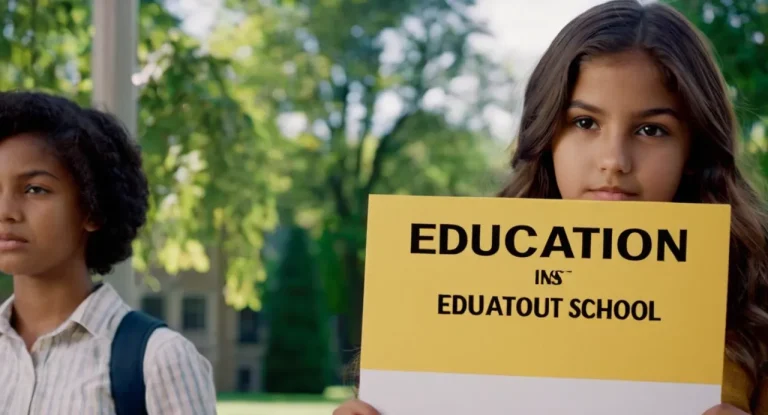Dropping out of school is a decision that can have far-reaching consequences, and it’s a topic that often sparks heated debates. If you’re a middle school student or a parent considering this option, it’s crucial to understand the implications and legal requirements surrounding this decision.
If you’re short on time, here’s a quick answer to your question: In most cases, it is not legal to drop out of middle school before reaching the age of compulsory education, which varies by state but is typically 16 or 18 years old.
In this comprehensive article, we’ll delve into the legalities, consequences, and alternatives to dropping out of middle school. We’ll explore the reasons why some students consider this path, the potential impact on their future, and the resources available to help them stay in school or pursue alternative educational options.
Legal Requirements for Dropping Out of Middle School
Dropping out of middle school is generally not permitted due to compulsory education laws in most states. These laws aim to ensure that every child receives a basic education, which is crucial for their personal growth and development, as well as for the well-being of society as a whole.
However, there are certain exceptions and exemptions that may apply in specific cases.
Compulsory Education Laws
Compulsory education laws vary from state to state, but they typically require children to attend school from a certain age (usually around 6 or 7) until they reach a specific grade level or age (often 16 or 18).
According to the National Center for Education Statistics, as of 2021, 24 states have set the compulsory attendance age at 18, while 15 states have set it at 17, and 11 states have set it at 16. These laws are designed to ensure that students receive a comprehensive education and develop the necessary skills for future success.
Exceptions and Exemptions
- Homeschooling: Many states allow parents to homeschool their children as an alternative to traditional public or private schools. However, homeschooling requirements vary from state to state, and parents must comply with specific regulations.
- Medical or psychological reasons: Some states may grant exemptions for students with medical or psychological conditions that make attending school difficult or impossible.
- Religious or philosophical beliefs: In certain states, exemptions may be granted for families whose religious or philosophical beliefs conflict with attending traditional schools.
Consequences of Violating Compulsory Education Laws
Violating compulsory education laws can have serious consequences for both students and their parents or guardians. Potential consequences may include:
- Fines or penalties for parents or guardians
- Involvement of child protective services or truancy officers
- Difficulty obtaining future employment or educational opportunities for the student
- Increased risk of involvement in criminal activities or substance abuse for the student
According to a study by the Center for American Progress, students who drop out of high school are more likely to face unemployment, poverty, and health issues later in life. The study found that high school dropouts earn an average of $8,000 less per year than high school graduates and are more likely to rely on public assistance programs.
😔
It’s important to note that while dropping out of middle school may seem tempting for various reasons, it can have long-lasting negative consequences for the student’s future. If you or someone you know is considering dropping out, it’s crucial to explore all available options and seek guidance from school counselors, social workers, or other professionals who can provide support and assistance.
👍
Reasons Why Students Consider Dropping Out of Middle School
The decision to drop out of middle school is a complex one, often driven by a combination of academic, personal, and socioeconomic factors. Understanding these underlying reasons is crucial for educators, parents, and policymakers to address this issue effectively and provide the necessary support to keep students engaged in their education.
Academic Struggles
Many students who consider dropping out of middle school face significant academic challenges. Learning difficulties, poor grades, or a lack of understanding of the subject matter can lead to frustration and a sense of hopelessness.
According to a study by the National Center for Education Statistics, approximately 16% of students who dropped out cited academic struggles as the primary reason. Without proper intervention and support, these students may feel overwhelmed and decide to leave school prematurely.
Personal or Family Circumstances
Personal or family circumstances can also play a significant role in a student’s decision to drop out of middle school. These may include health issues, family responsibilities, or challenging home environments.
Some students may need to work to support their families financially, making it difficult to balance school and work commitments. According to a report by Child Trends, approximately 25% of dropouts cited personal or family reasons as the primary factor.
Peer Pressure and Social Issues
The middle school years are a critical period for social development, and peer pressure can significantly influence a student’s decision to drop out. Bullying, social isolation, or negative influences from peers can contribute to a student’s disengagement from school.
Additionally, students who struggle with social skills or have difficulty forming positive relationships may feel disconnected and choose to leave school. According to a study by the Centers for Disease Control and Prevention, approximately 20% of students who dropped out reported experiencing bullying or social issues.
Financial Constraints
Financial constraints can also be a significant barrier to staying in school. Families facing economic hardship may prioritize immediate financial needs over education, leading students to drop out and seek employment.
Additionally, the cost of school supplies, transportation, and extracurricular activities can be burdensome for low-income families. A report by the Education Week Research Center found that nearly 30% of dropouts cited financial reasons as a contributing factor.
Addressing these diverse reasons requires a multifaceted approach involving schools, families, and communities. By providing academic support, counseling services, anti-bullying programs, and financial assistance, we can help ensure that every student has the opportunity to succeed and stay engaged in their education.
Remember, dropping out of middle school can have long-lasting consequences, so it’s crucial to intervene early and provide the necessary support to keep students on track.
Potential Consequences of Dropping Out of Middle School
Limited Career Opportunities
Dropping out of middle school can severely limit one’s career prospects and earning potential. Without a high school diploma or equivalent, individuals often find themselves restricted to low-paying, entry-level jobs with little room for advancement.
According to a study by the National Center for Education Statistics, high school dropouts earn an average of $7,000 less per year than those with a high school diploma. This income gap widens over time, making it increasingly difficult for dropouts to achieve financial stability and independence.
Increased Risk of Poverty and Unemployment
The lack of education and skills acquired through middle and high school can significantly increase the risk of poverty and unemployment. A report by the Bureau of Labor Statistics revealed that in 2022, the unemployment rate for individuals without a high school diploma was a staggering 10.5%, compared to just 3.5% for those with a bachelor’s degree or higher.
Furthermore, the poverty rate for high school dropouts was a concerning 24.3%, more than double the national average. These statistics highlight the profound impact that education can have on one’s economic well-being and overall quality of life.
Social and Emotional Impact
Dropping out of middle school can have far-reaching social and emotional consequences. Without the structure and support provided by the educational system, young individuals may struggle to develop essential life skills, such as time management, problem-solving, and interpersonal communication.
This can lead to a sense of isolation, low self-esteem, and a higher risk of engaging in harmful behaviors like substance abuse or criminal activities. 😔 According to a study by the Interagency Working Group on Youth Programs, dropouts are more likely to experience mental health issues, such as depression and anxiety, further compounding the challenges they face.
Difficulty Returning to Education
For those who drop out of middle school, the path to re-entering the educational system can be arduous and challenging. Many states have strict age limits and requirements for enrolling in traditional high schools, making it difficult for older individuals to continue their education through conventional means.
Alternative options, such as adult education programs or online courses, can be expensive and may not provide the same level of support and resources as traditional schools. Additionally, the longer an individual remains out of the educational system, the harder it becomes to reacquire the necessary skills and knowledge to succeed academically.
👏 Organizations like the National Dropout Prevention Center offer resources and support to help individuals overcome these barriers and re-engage with their education.
Alternatives to Dropping Out of Middle School
Dropping out of middle school can have severe long-term consequences, including limited job opportunities, lower earning potential, and a higher risk of poverty. However, there are several alternatives available for students who are struggling academically or facing personal challenges that make traditional schooling difficult.
These alternatives aim to provide a supportive environment and flexible learning options to help students stay engaged and on track for success.
Tutoring and Academic Support
Many schools offer free or low-cost tutoring programs to help students who are falling behind in specific subjects. Working with a tutor can provide personalized attention and targeted instruction to address areas of weakness.
Additionally, some organizations like Tutors.com and Varsity Tutors offer online tutoring services for a fee. According to a study by the National Education Association, students who receive regular tutoring can improve their grades by as much as 30%. 🎉
Alternative Education Programs
Some school districts offer alternative education programs designed for students who struggle in traditional classroom settings. These programs may include smaller class sizes, more individualized instruction, and a focus on hands-on or project-based learning.
Examples of alternative education programs include charter schools, magnet schools, and career and technical education programs. According to the National Center for Education Statistics, in the 2017-2018 school year, there were over 7,000 public charter schools in the United States, serving approximately 3.2 million students.
👏
Online or Distance Learning
With the rise of technology, online or distance learning has become an increasingly popular option for students who prefer a more flexible or self-paced learning environment. Many school districts and organizations offer accredited online courses or virtual school programs that allow students to complete their coursework remotely.
According to a report by the International Association for K-12 Online Learning, over 2 million K-12 students in the U.S. were enrolled in online courses in 2016. 😮
Counseling and Mentorship Programs
For students facing personal or emotional challenges that are impacting their academic performance, counseling and mentorship programs can provide valuable support. School counselors can help students develop coping strategies, set goals, and connect them with appropriate resources.
Mentorship programs, such as those offered by organizations like Big Brothers Big Sisters, pair students with adult mentors who can provide guidance, encouragement, and a positive role model. According to a study by Mentoring.org, students who participate in mentorship programs are 55% more likely to enroll in college and 78% more likely to volunteer regularly in their communities.
👍
Conclusion
Dropping out of middle school is a decision that should not be taken lightly, as it can have profound and long-lasting consequences. While the legal requirements and potential consequences vary by state and individual circumstances, it’s crucial to explore all available alternatives and seek support before making such a significant choice.
Remember, education is a powerful tool that can open doors to countless opportunities and a brighter future. By understanding the legal implications, potential risks, and available resources, you can make an informed decision that aligns with your goals and aspirations.
Seek guidance from educators, counselors, and trusted mentors to navigate this challenging situation and find the best path forward.






